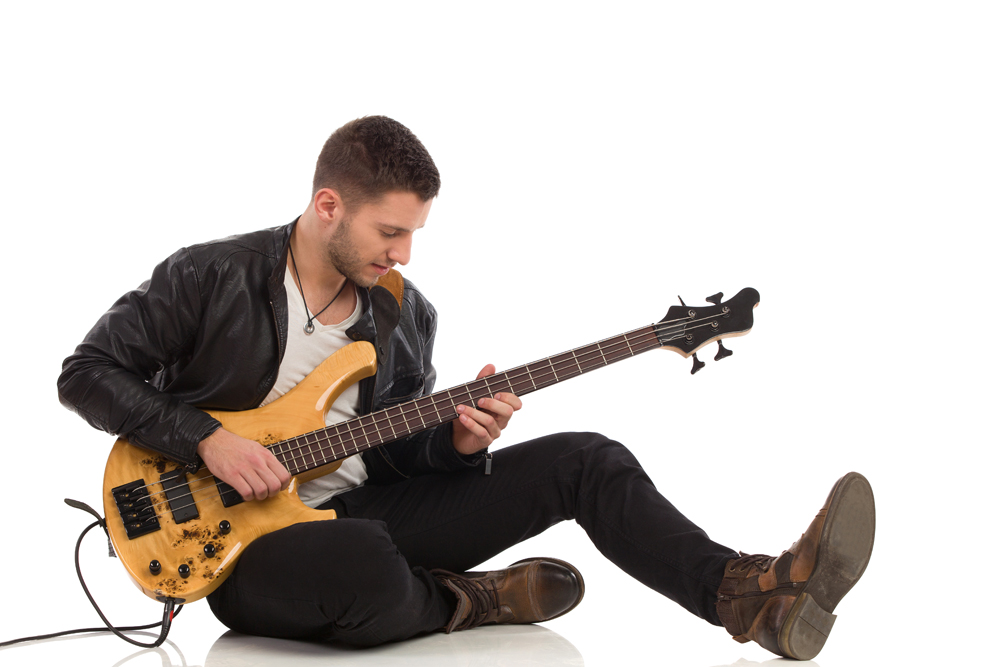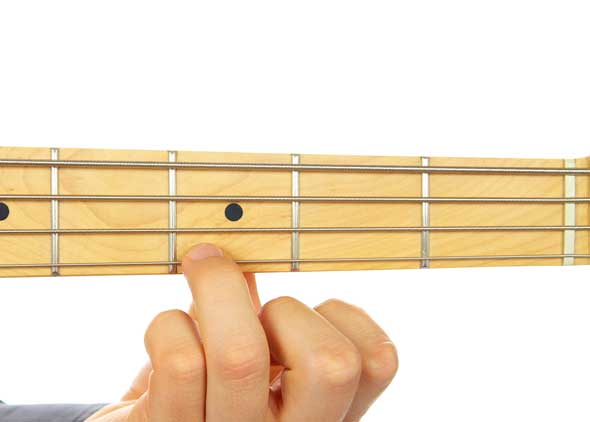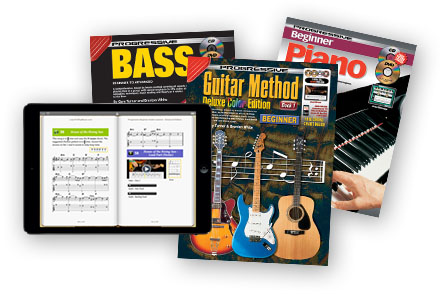For anyone starting out learning how to play the bass, one of the most important questions to answer early on is “How to hold a Bass Guitar”. If you start out holding the bass correctly, than it will be easier for you to play and you will learn faster.
For a comfortable playing position, it is best to use a strap. A wide strap, approx. 2-3 inches (8-10cm) is best, so the weight of the bass is evenly distributed. Adjust the strap to a length that is comfortable. The full weight of the bass should be resting on the shoulder strap.
The bass should be angled slightly upwards (see photo below), so that your left arm is free to move while you play.
Whether you prefer to sit or stand while you play, make sure that the position of your bass (strap length and angle) is the same so that your playing won’t be affected. Keep the bass close to your body so that it is easy to reach all parts of it when you play.
The Right Hand
To play the notes on the bass you can either:
- Use the fingers of your right hand to play the strings or,
- Use a pick (which is a piece of plastic shaped like a triangle held in the right hand) to play the strings.
Most bass players use the right hand fingers to play the strings. Some Rock bass players prefer using a pick because it gives a crisper sound.
Using Your Fingers
The fingers of the right hand are named as shown in the following diagram. Use the ‘m’ and ‘i’ fingers to play the strings.
The thumb (T) is used to support your right hand by resting it on the bass pickup as shown in the photograph. Most modern bass guitars have two pickups. One close to the fretboard and a second one nearer the bridge. In the early stages of playing, it may be easier to place your thumb on the front pickup as the string tension is not quite as “hard” as on the back pickup. The tone will also sound fuller and heavier, and it will also be easier for your right hand fingers to play the strings.
You should also experiment by playing with your thumb resting on the back pickup as the sound is clearer and has more attack and “bite”.
The Rest Stroke
When playing notes with your fingers, the rest stroke is used. The rest stroke involves the finger playing the string and then coming to rest on the next string. The photos below illustrate the movement of the index finger when playing the rest stroke.
Alternate between your index (i) and middle (m) fingers, making sure that one of the two fingers is always resting on a string while the other is playing a string.
Always use this alternating finger style as it will give you more possibilities when changing between notes and strings.
Using a Pick
Picks are usually made of plastic and come in a variety of different shapes and thicknesses. Most bass players prefer a medium or thick gauge pick, as thin picks tend to give a less defined sound.
The Left Hand
Left Hand Placement
Your fingers should be on their tips and placed just behind the frets (not on top of them).
For greater support, the left hand thumb should be placed behind the neck of the bass, approximately opposite your index and middle fingers as shown in the photo below.
The left hand fingers are numbered as shown in the following photograph. The left hand finger number, if needed, is written next to the music note.












































I hav learn alot here. Am so hapi 2 login on dis site
i use my right thumb to play the guitar is it wrong????? My index & middle fingers are so slow so its easy if im using my thumb is it a bad idea
Hi Zelda, Using the thumb is wrong and will get you into bad habits and slow your progress as you get better. Using the fingers is the most popular way for bass players but you can also use a pick if you like. Practice a little every day and within no time you will get faster.
For the guitar its corect, but for the bass its incorect
I have recently bought your begginer bass book and it shows to place the thumb on the pick up (as shown in the blog as well) but in the accompanying DVD it can seen the player travels with the thumb down the strings (the technique shown by others to cause less strain of the hand). What is the advised technique I should use as a beginner?
Hi Michael,
Thanks for your question. As a beginner we recommend anchoring your thumb to form good technique. As you become more confident and move on to more advanced songs & bass books, you can start floating your thumb to mute the strings.
The sitting position illustrated can lead to back problems since the spine is shaped into an S. It’s better to not use a foot rest or to rest the bass on your left leg or wear a strap.
Also, the right hand technique should be adopted from classical guitar technique. Do not anchor the thumb, let it follow the hand and mute lower strings as you ascend. It is also fine to use the 3d finger of the right hand, it may be harder in the beginning…but you’ll thank me later.
please can I get a diagram showing the sol-fa notations on a bass guiter?
Hi Ellis, Check out Progressive Beginner Bass Guitar – Lesson Six has what you need. This is also available as an eBook here.
I have been playing bass for about 9 months already, and I use my thumb, index, and middle fingers to play the strings. I can play really well and fast with this technique but I’m trying to learn to play with a pick as well. I just can’t seem to. I have trouble stopping the strings and I hit other strings frequently. Any tips?
Hi Elijah, sounds like you’ll need to put in some solid practise hours with the pick to bring yourself up to the same standard as you are with your fingers. You’ll need to learn both right hand and left hand dampening techniques to keep the strings under control. Take it very slowly at first and gradually increase speed as your accuracy improves. Super important to get your technique right at this stage otherwise it will hold you back later on.
I’m not able to figure out a comfortable way to hold my fretting hand. When I’m playing the E string and going up and down the neck the palm of my hand slide on the G string. If I try to hold my hand in such a way as to not do that it’s extremely uncomfortable to the point of hurting. What am I doing wrong!?
Hi Steve, if I understand you correctly, you’re trying to work out how to play notes on the E string without the rest of your left hand touching any other strings. Unlike playing chords on a guitar, on a bass guitar where you are mostly playing single notes – this is not necessary and in fact, it is helpful if your fingers/palm are touching the other strings that you are not currently playing notes on – as this helps to keep them from making any unwanted sound. Apart from the finger you are using to fret the note you are playing, let the rest of your left hand relax when you are playing. Hope this helps.
Hello. How much pressure should my left thumb be applying to the neck?
Hi Jonathan, just apply enough pressure with your thumb to enable your fingers to fret the notes cleanly – so that they do not buzz (making sure you press the strings with your finger tips close the fret will help with this too). Your left hand should be as relaxed as possible apart from this. When practicing, take regular breaks to let your hands fully relax. It takes a while for your hands and brain to learn to do what you want them to – but it will come if you keep at it daily…
Thanks for the information
Practicing is hard. You may be frustrated with your practice techniques and your skill levels may have begun to plateau.
I’ve got the same problem like the other guys especially with the left thumb I feel pain on my wrist when I’m practising fingering, do I need to press my thumb hard to the back of the neck or not ?
Hi, as mentioned above, you just need to apply enough pressure with your thumb to enable your fingers to fret the notes cleanly – so that they do not buzz. You should not feel any pain. If you do then take a break and try again the next day. You will gradually build up the strength needed. It’s also SUPER important that you have the correct technique as shown in the photos above. Bad habits when you are just starting out can be difficult to correct later on. We’d strongly recommend you get some lessons with a professional bass guitar teacher at some point to make sure of this. Have fun!
Thank you so much for these invaluable informations…
I want to ask if theirs any conventional rules guiding the placement of your left fingers on the fretboard?
Thank you once again!